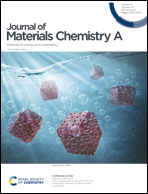When photoluminescence, electroluminescence, and open-circuit voltage diverge – light soaking and halide segregation in perovskite solar cells†
Abstract
Perovskite solar cells suffer from various instabilities on all time scales. Some of them are driven by light, in particular when employing compounds with mixed halides. Such light soaking effects have been observed to result in performance changes of solar-cell devices. They have also been spectroscopically investigated in detail on films, where the formation of a low-gap iodine-rich phase, seen as a red shift of the PL, has been found to be responsible for a reduced open-circuit voltage. However, studies synchronously examining device performance and its relation to spectroscopy data are scarce. Here, we perform an in operando study, where we investigate the changes of open-circuit voltage (Voc) and photocurrent during light soaking and complement them with photo- (PL) and electro-luminescence (EL) data on devices, which allow analysis of the Voc-limiting processes using optical and optoelectronic reciprocity relations. We find that changes in the Voc for stable single halide compositions are quantitatively correlated with changes in the PL intensity, showing that the Voc follows changes in the quasi-Fermi level splitting. In contrast, changes in Voc for the mixed halide composition are not correlated with the emergence of the low-gap phase, confirming that this phase is not the sole culprit for a low and unstable Voc. Instead, non-radiative voltage losses influenced by mobile ions are dominant in devices containing compositions with high Br content. Interestingly, the low-gap phase contributes less to photocurrent, as seen by a wavelength-dependent PL quenching at short circuit. This observation might be explained by the formation of emissive but partially insulated iodine-rich regions in the film. Such an effect is also possible for single halide systems, when the perovskite composition is not stable, seen in an increase of PL at short circuit during light soaking. This indicates that ion migration in general causes photovoltaically inactive regions, without enhancing non-radiative recombination, an effect that might need to be considered in the analysis of PL quantum yields. EL measurements confirm that Rau's reciprocity relation between the external EL quantum efficiency and Voc cannot readily be applied to absorbers with such different phases.



 Please wait while we load your content...
Please wait while we load your content...